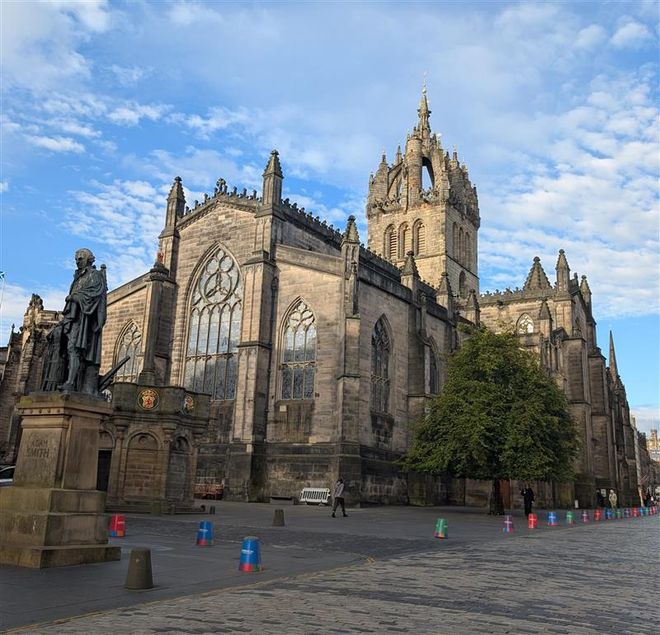The city of Edinburgh, Scotland, along with the prominent St. Giles' Cathedral, recently celebrated turning 900 years old. As part of the joint celebration, St. Giles' Cathedral hosted an exhibit showcasing the lives of some of Edinburgh’s earliest residents.
Data pulled from the remains of these individuals, who were buried within St. Giles and exhumed in 1981, revealed their health, diet, and even their faces — digitally reconstructed. But one of the most fascinating finds comes from a teenage boy. After analyzing his teeth, researchers found that he likely died from the Black Death — or, the bubonic plague.
Read More: Black Death Bacterium Evolved to be Less Aggressive to Kill Victims Slowly
Black Death Found at St. Giles’ Cathedral

St. Giles' Cathedral in Edinburgh, Scotland, September 2025
(Image Courtesy of Monica Cull)
In 1981, a team of researchers began excavating an area within St. Giles’ Cathedral before a remodeling project that was set to take place. During their excavation, researchers uncovered pottery, ceramic building materials, bone objects, metal fragments, medieval glass, coins, and over 100 human remains. After the excavation, the remains were held within the city archives until recently.
As part of the city’s 900th birthday, researchers from the Francis Crick Institute in London and Edinburgh, Aberdeen, and Dundee universities teamed up to bring a little life back into these bygone residents.
One of the skeletons uncovered belonged to a teenage boy who died sometime during the 14th century. Reseachers from the Francis Crick Institute in London examined the boy’s teeth, conducting isotopic analysis of his plaque, along with DNA sequencing and radiocarbon dating.
Within the plaque, the team found bubonic plague pathogens, providing the first scientific evidence of the Black Death in Edinburgh, according to the BBC.
Outbreak of the Plague in Edinburgh
The bacterium Yersinia pestis was the primary cause of the Black Death, which raged across Europe for centuries. It wasn’t until the 19th century that doctors discovered that fleas on infected rats spread the Black Death. The fleas would bite the infected rats, then hop to human victims, bite them, and spread the bacteria.
The name Black Death comes from the fact that some patients would experience skin lesions and gangrene, which turned the skin black.
According to the National Library of Scotland, the plague first arrived in Scotland in 669 C.E., though it was mostly contained to the areas around Edinburgh. However, in the mid-1300s, Scotland experienced an epidemic-level outbreak of the plague. These outbreaks lined up with the death of the teenage boy buried in St. Giles’.
What’s interesting to note is that during these plague outbreaks, so many people often died that the deceased were buried together in mass graves. The boy in St. Giles’, though, was buried with care.
Gone But Not Forgotten
Along with finding scientific evidence of the Black Death, the excavation and work put in by the multi-institution research team have brought back artifacts and stories from some of Edinburgh's first residents.
Maria Maclennan, a senior lecturer at The University of Edinburgh, led a forensic facial reconstruction project on five of the human remains exhumed from St. Giles’. These are on display at St. Giles’ through November 2025.
Other research pinpointed the diets, health, and even the lineage of the people who were once buried at the cathedral.
“This has been a fascinating project that brings together new archaeological science and the creative arts to tell the story of Edinburgh's first residents in an imaginative and exciting way,” said John Lawson, the City of Edinburgh Council archaeologist, in a press statement.
“Visitors to the exhibition will come face-to-face with the first inhabitants of the city, ordinary individuals who lived through extraordinary chapters of history. While we are accustomed to the tales of the famous and powerful, this project shifts the spotlight to the everyday citizens, telling their stories in the very place they once walked, worshipped, and were laid to rest,” Lawson concluded.
Read More: Medieval Squirrels Served as First Ancient Hosts of Leprosy
Article Sources
Our writers at Discovermagazine.com use peer-reviewed studies and high-quality sources for our articles, and our editors review for scientific accuracy and editorial standards. Review the sources used below for this article:
- This article references information from the National Library of Scotland: The plague in Scotland
- This article references information from the BBC: First scientific evidence of Black Death in Edinburgh found on skeleton
- This article references information from The City of Edinburgh Council: Edinburgh 900 exhibition reveals the hidden lives of the first ‘Edinburghers’
- This article references information from a study in the Society of Antiquaries of Scotland: Archaeological excavations in St Giles’ Cathedral Edinburgh, 1981–93

.jpg) 2 hours ago
2
2 hours ago
2
 English (US)
English (US)